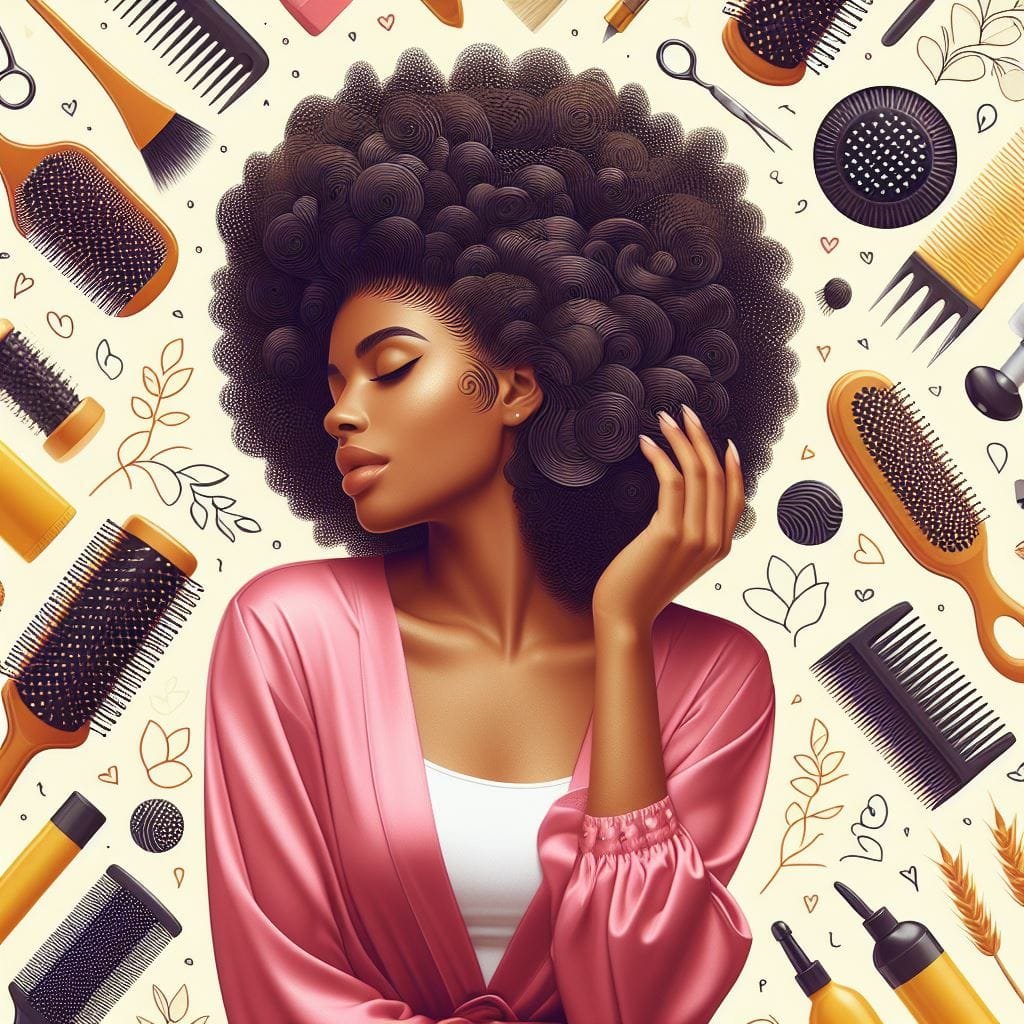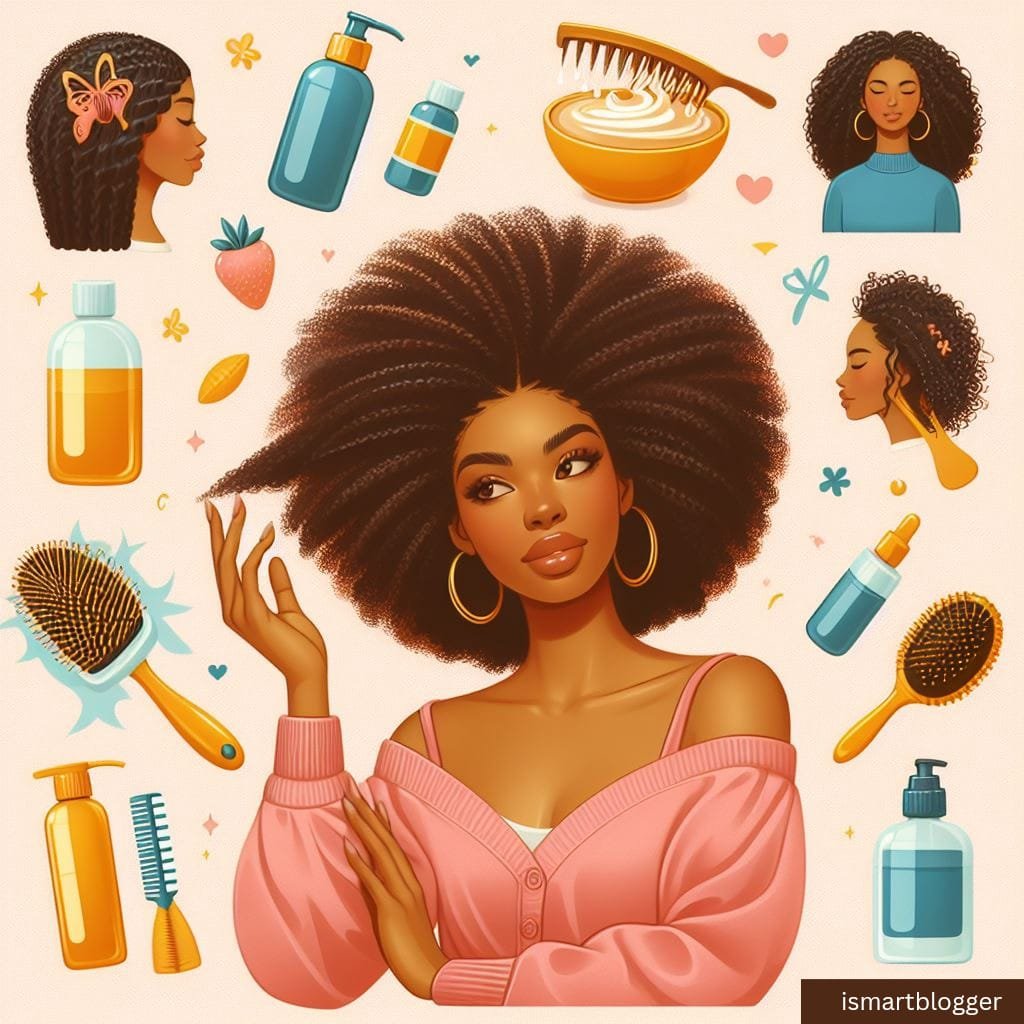Introduction
African-American hair is undeniably unique and fascinating. Its diversity spans from tight coils to soft waves, boasting an array of textures, thicknesses, and curl patterns that set it apart from other hair types.
This distinctiveness stems from the structure of the hair follicles and the genetic makeup of individuals with African ancestry. Understanding these characteristics is crucial to implementing effective care and maintenance routines that promote healthy hair growth and minimize damage.
Brief Overview of the Uniqueness of African-American Hair
African American hair possesses a spiral or helix-shaped follicle structure, which causes it to grow in a curved pattern rather than straight. This curvature results in a more intricate texture compared to other ethnicities. The hair strands tend to be finer in diameter but have more density per square inch, making it appear voluminous even with less overall hair mass.
Furthermore, due to the curvature of each strand, natural oils produced by the scalp face difficulty traveling down toward the ends of the hair, leading to potential dryness and moisture retention challenges. Another key characteristic of African-American hair is its propensity for shrinkage when exposed to moisture or humidity.
This phenomenon can cause significant frustration for individuals who desire length retention as their natural curls may appear shorter than they are when dry. However, this unique trait also grants African American hair versatility as it can be manipulated into various styles such as afros, twists, braids, locs, or sleek updos.

Importance of Proper Care and Maintenance for Healthy Hair
Proper care and maintenance play pivotal roles in maintaining healthy African-American hair. Due to its specific needs related to texture and structure, neglecting essential practices can result in breakage, excessive shedding, dryness, or brittleness – all hindrances on the path towards achieving long-lasting luscious locks. By implementing a well-rounded hair care routine, individuals with African-American hair can enhance their natural beauty and resilience.
Regular cleansing, conditioning, and moisturizing are vital for maintaining the balance of moisture and oils within the hair strands. Adequate hydration prevents dryness and breakage, promotes elasticity, and preserves natural curl patterns.
Additionally, incorporating protective styling techniques helps shield the delicate ends of the hair from environmental damage while also allowing for length retention. African-American hair possesses unique characteristics that require specialized care methods to maintain optimal health.
Understanding its distinct structure enables individuals to develop proper maintenance routines that address specific needs related to moisture retention and protection against damage. By embracing these practices, individuals can unlock their hair’s full potential for growth, strength, and beauty.
Understanding African American Hair
Explanation of hair texture and structure
African-American hair is often characterized by its unique texture and structure. Unlike other hair types, African American hair tends to be more costly, curly, or kinky. This is due to the shape of the hair follicles, which are more elliptical or flat as opposed to round.
The natural curl pattern of African American hair can vary from loose curls to tight coils, with each individual having a distinct texture. Furthermore, African-American hair is prone to dryness due to its structure.
The curved shape of the strands makes it difficult for natural oils produced by the scalp to travel down the hair shaft, resulting in less moisture retention. This leads to a higher risk of breakage and damage if not properly cared for.
Differences between natural and chemically treated hair
A significant aspect of caring for African-American hair lies in understanding the distinctions between natural and chemically treated (relaxed or permed) hair. Natural African American refers to untreated or unaltered hair that has not undergone any chemical processes to permanently straighten or alter its texture. Chemically-treated African American hair has been altered using relaxers or perms that break down the protein bonds in the strands, leading to a straighter appearance.
However, these processes can weaken the structure of the hair if not done correctly or maintained properly. It’s important to note that chemically treated hair typically requires more intensive care due to its increased susceptibility to damage.
Regular deep conditioning treatments and protective styling become even more crucial for maintaining healthy chemically-treated African American hair. Understanding these aspects of African-American hair sets a foundation for implementing effective care techniques specific to this unique type of hair.
Daily Hair Care Routine
Shampooing and Conditioning Techniques for African-American Hair
Proper shampooing and conditioning techniques are paramount when caring for African-American hair. The unique texture of this hair type requires specific attention to retain moisture and prevent dryness. When shampooing, it is crucial to opt for sulfate-free shampoos, as sulfates can strip the hair of its natural oils, leading to dryness and breakage.
Look for gentle cleansers that effectively remove dirt and build-up without compromising the hair’s moisture balance. When applying shampoo, focus on the scalp by gently massaging it with your fingertips to stimulate blood circulation.
Avoid rough scrubbing motions as they can damage the delicate strands. Rinse thoroughly with lukewarm water, ensuring all product residue is removed from both the scalp and the lengths of your hair.
Importance of Sulfate-Free Shampoos to Retain Moisture
Sulfate-free shampoos are a gamechanger when it comes to preserving moisture in African American hair. Sulfates are harsh detergents commonly found in many commercial shampoos that create lather but also strip away natural oils from the scalp and strands.
This can lead to excessive dryness, frizz, and breakage. By using sulfate-free shampoos specifically formulated for African-American hair, you optimize moisture retention while still effectively cleansing your scalp and hair.
These gentle cleansers maintain the natural oils necessary for keeping your tresses hydrated and healthy. They help prevent frizz, reduce tangling, and enhance overall manageability.
Deep Conditioning Treatments to Nourish and Strengthen the Hair
Deep conditioning treatments are essential steps in any African-American hair care routine as they provide intense hydration, nourishment, and strength to the strands. Deep conditioners usually contain richer formulations and higher concentrations of moisturizing ingredients that penetrate the hair shaft deeply.
To deep condition your hair, start by washing it with a sulfate-free shampoo. Squeeze out excess water and apply the deep conditioner generously, focusing on the mid-lengths and ends where moisture is most needed.
For an added boost, cover your hair with a plastic shower cap or wrap it in a warm towel to create a steamy environment that helps the product penetrate even more deeply. Leave the conditioner on for at least 15-30 minutes, allowing it to work its magic before rinsing thoroughly with cool water.
Incorporating regular deep conditioning treatments into your routine can significantly enhance the health and vitality of your African-American hair. These treatments replenish moisture, restore elasticity, and protect against damage caused by heat styling or environmental factors.
Aim to deep condition at least once a week or as needed based on your hair’s specific needs and level of damage. Remember, consistent adherence to these shampooing and conditioning techniques will help maintain healthier African-American hair by retaining crucial moisture levels and fortifying its structure through proper nourishment.
Moisture Retention Techniques
The Importance of Moisturizing Regularly for African American Hair
Moisture retention is crucial for the health and vitality of African-American hair due to its unique structure. The natural coil pattern of this hair type makes it more prone to dryness, as the sebum produced by the scalp has a harder time traveling down the strands. Without proper moisture, African American hair can become brittle, dull, and susceptible to breakage.
That is why regular moisturizing is essential to maintain its strength and luster. To effectively moisturize African American hair, it is advisable to follow a consistent routine.
Begin by thoroughly cleansing your scalp using a sulfate-free shampoo that won’t strip away natural oils. After rinsing out the shampoo, apply a hydrating conditioner from roots to ends.
Leave it on for a few minutes before rinsing with lukewarm water. This step helps replenish moisture lost during washing while also providing nutrients necessary for healthy hair growth.
Use of Leave-in Conditioners or Moisturizers to Prevent Dryness
In addition to regular conditioning in the shower, incorporating leave-in conditioners or moisturizers into your daily routine can work wonders for maintaining moisture levels in African-American hair. These products are specifically designed to be applied after washing and left on without rinsing out, providing continuous hydration throughout the day.
When choosing a leave-in conditioner or moisturizer, opt for one formulated with ingredients like shea butter or argan oil, which have excellent emollient properties that help lock in moisture and keep your hair soft and supple. Apply a small amount evenly through your strands using your fingers or a wide-tooth comb, paying extra attention to the ends where dryness tends to accumulate.
Protective Hairstyles that Help Retain Moisture
Protective hairstyles play a vital role in moisture retention for African-American hair. These styles create a barrier against environmental factors and friction, reducing the chances of water loss and damage.
Braids and twists are two popular protective options that not only safeguard your hair but also aid in locking moisture within the strands. Braids, such as box braids or cornrows, involve weaving sections of hair together tightly.
This style not only offers versatility but also helps retain moisture by keeping the strands neatly arranged and sheltered from external elements. Similarly, twists, whether two-strand or flat twists, provide a protective shield by gently wrapping sections of hair around each other.
These styles can be worn for an extended period, allowing the hair to rest while maintaining optimal hydration levels. By consistently moisturizing your hair using leave-in conditioners or moisturizers and incorporating protective hairstyles like braids or twists into your routine, you can effectively retain moisture in African-American hair.
Doing so will promote healthier strands that are less susceptible to dryness and breakage. Remember that consistency is key when it comes to maintaining moisture levels, so make these techniques part of your regular care regimen for beautiful and nourished hair.
Heat Styling Precautions
Minimizing heat damage on African-American hair When it comes to heat styling, African-American hair requires some extra care and attention. The high heat from styling tools can cause significant damage, resulting in dryness, breakage, and even irreversible harm to the hair strands.
To minimize heat damage and maintain healthy hair, it is crucial to adopt certain precautions. One essential step is using a heat protectant spray before subjecting your hair to hot tools.
Heat protectants create a barrier between the intense heat and your precious strands, reducing the risk of damage. Look for products specifically designed for African-American hair, as they often contain additional moisturizing ingredients that help retain moisture while shielding against thermal stress.
In addition to using a heat protectant spray, another precautionary measure is lowering the heat settings on your styling tools. While it may be tempting to crank up the temperature for faster results, excessive heat can be detrimental to African-American hair.
Opt for lower temperatures and gradually increase if needed. Remember that patience is key when it comes to protecting your mane from unnecessary damage.
Protective Styling Options
Introduction to protective hairstyles for African American hair thrives when it’s given a break from constant manipulation and exposure to damaging elements like harsh weather or friction with clothing. Protective hairstyles offer an effective way of safeguarding your tresses while still maintaining an elegant look.
One popular protective hairstyle option is box braids. Originating from various African cultures, box braids have gained popularity worldwide due to their versatility and protective qualities.
These braids involve sectioning the hair into small square-shaped portions before weaving them into intricate patterns using extensions. Box braids not only minimize breakage but also provide an opportunity for hair growth and reduced styling time.
Another protective style, twists, comes in various forms such as two-strand twists or flat twists. Two-strand twists involve twisting two sections of hair together, while flat twists are created by plaiting small sections of hair close to the scalp.
Twists help retain moisture and protect the ends of your hair from damage. With proper care, they can last for several weeks, making them an excellent low-maintenance option.
In addition to braids and twists, wigs and weaves offer temporary protection and versatility. Wigs can be easily switched up to suit different styles or occasions while allowing your natural hair to rest beneath.
Weaves involve adding extensions directly onto the braided or cornrowed natural hair for added length or volume. However, it is vital to ensure that these styles are installed properly and maintained regularly to prevent potential damage.
Scalp Health Maintenance
The importance of a healthy scalp for overall hair health A healthy scalp is the foundation of beautiful African-American hair.
Neglecting scalp health can lead to issues like dandruff, dryness, itching, or even hindered hair growth. To maintain optimal scalp health and promote luscious locks, certain practices should be adopted.
Regular scalp massages are an effective way to stimulate blood circulation in the scalp area. Gentle massaging motions with your fingertips can increase nutrient-rich blood flow to the follicles, promoting healthier roots and potentially boosting hair growth.
Additionally, regular massages distribute natural oils more evenly throughout the strands while also relieving stress and tension. Embracing natural remedies can also address common scalp issues without resorting to harsh chemicals that may further aggravate the problem.
For dandruff, using tea tree oil or apple cider vinegar as a scalp treatment can help alleviate symptoms and restore balance. For dryness, incorporating natural oils like coconut or jojoba oil into your scalp care routine can provide much-needed hydration.
Conclusion
Caring for African American hair requires specialized attention to unique needs and characteristics. By taking precautions to minimize heat damage through the use of heat protectant sprays and lower heat settings on styling tools, you can prevent excessive drying and breakage.
Additionally, exploring protective styling options like box braids, twists, wigs, and weaves provides an opportunity for both hair protection and versatility. Never overlook the importance of maintaining scalp health.
Regular massages and natural remedies can contribute to overall hair health by promoting blood circulation and reducing common scalp issues like dandruff or dryness. With dedication and mindful care techniques tailored to African-American hair types, you can achieve vibrant locks that exude beauty and radiance.





